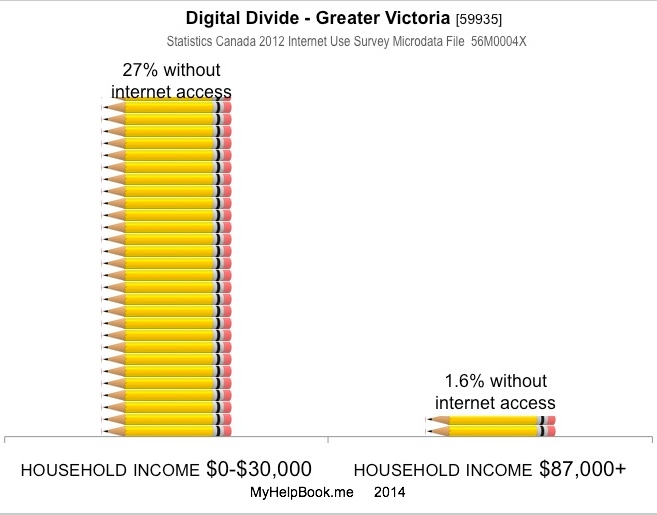|
The digital divide can be broadly described as the gap between those with good access to the internet and those without, or, more precisely: "consumer disparities in access to information and communication technologies." * This gap, not surprisingly, is biggest for those who have the smallest incomes. A 2012 Statistics Canada survey (CANSIM Table 358-0152) shows that in Greater Victoria the top income group of $87,000+ (per year) has 98.4 percent internet access and 1.6 percent without. The lowest income group of $0-$30,000 has a significant 27 percent without internet access. A similar but slightly smaller gap exists in Metro Vancouver. The lowest income group has 20.9 without internet access compared to 9.5 without for the highest income group. Canada-wide it is 5 percent without access for highest income group and 38 percent without for the lowest income group (attributed to more rural/urban differences). Larry Gagnon is a long-time volunteer with "Find a Computer A Home" in Victoria which has been providing low income people in Victoria with good quality donated used computers for the last 20 years. Recently he's seen a drop in requests for free computers (which have become more affordable), however, the bigger problem is lack of affordable home internet service. This is evident in the number of people who use public computers at cafes, community centres, job centres, and libraries. "There is heavy usage of public computers all the time, all day, and at all branches," says Kate Pollock of the Greater Victoria Public Library who tracks of public computer use for the GVPL (available to library card holders for one hour at a time, and a maximum of two hours a day). She emphasizes: "It's our mandate to bridge the digital divide and provide equal opportunity for information access for everybody. The internet is part of that." Greater Victoria Public Library stats: As a one-day snapshot of public computer use, on Friday, April 25th there were 743 sessions (each session is a separate person's log-in) throughout the GVPL's ten branches (a total of 644 online hours). In one month (March 2014) there were 22,578 sessions all ten branches: the busiest being Central downtown 9,573, then Saanich 2,122, Esquimalt 1,751, Nellie McClung 1600 and Oak Bay 1,600. For the year of 2013, there were a total of 247,610 sessions system-wide. Source: Kate Pollock, Customer Service Coordinator, Greater Victoria Public Library. Lack of internet access is a huge barrier for people who need to find help online or who need to apply for jobs, programs or benefits. Less obvious but more poignant is the impact on isolated people who might also lack transportation or mobility and who are desperate to stay in touch with friends and family. And politically, the digital divide is a double democracy whammy: lack of access to information (being informed) and lack of ability to give information (having your voice heard). Larry from 'Find a Computer A Home' gets many phone calls from grateful people who want to let him know what a huge difference having a computer has made in their lives. The most commonly stated benefits are: a) it helped them find employment; b) it allowed them to stay connected with family; c) it allowed them to learn practical computer skills and d) it gave them enjoyment of learning. A digital divide however, is not just lack of computers and internet access. There are other less obvious barriers to online access:
During the development of My Help Book, the most frequently asked question was: “why are you publishing a paper guide?” This reflects the widely held assumption that everyone has easy access to the internet and it shows how the digital divide is mostly an invisible problem –especially when other social problems are more visible and urgent. That public computer terminals in libraries are full to bursting from opening time to closing time demonstrates the size of this invisible problem. More Resources and Information:
*Digital Divide definition: "consumer disparities in access to information and communication technologies based on age, gender, race and socio-economic characteristics and geographic location." Seçkin, G. (2010). Digital Diversity or Digital Divide: An Exploratory Research on Age, Gender, Race and Income Characteristics of Online Health Information Users. International Journal of Diversity in Organisations, Communities & Nations, 10(1), 99-116; cited in 'Closing the Digital Divide and Its impact on Minorities' (PDF). Written in 2014, updated 2016 |
AuthorMy Opportunity & Help Book BC Categories
All
Archives
December 2020
|
Proudly powered by Weebly

 RSS Feed
RSS Feed